-
PKW mit Gedankensteuerung
von Arne am 17.02.2011 um 23:33 Uhr
Moderne Automobile bringen immer mehr Technologie mit, die den Fahrer beim Fahren entlasten sollen. Vielfach noch optional und in teureren Autos, gibt es mittlerweile Hilfe von Fahrerassistenzsystemen beim Spurwechsel, Spurhalten, Einparken, Bremsen und mehr. Dass dieser Weg nicht unbedingt die volle Autonomie des Fahrzeugs zum Ziel haben muss, zeigt das folgende Video des Berliner Autonomous Labs, in dem sich das Auto zwar selbstständig über die Fahrbahn bewegen kann, die Entscheidung zur Fahrtrichtung kommt aber weierhin vom Fahrer … per Gedankensteuerung:
Your browser needs to support Flash contents to display this image. PKW mit GedankensteuerungDer BrainDriver aus der Arbeitsgruppe von Raúl Rojas an der FU Berlin.
zu den Kommentaren
-
Robuste Roboterhand vom DLR
von Arne am 10.02.2011 um 17:01 Uhr
Einen Vorgeschmack zur weiteren Entwicklung in der Robotik hat das Deutsche Zentrum für Luft- und Raumfahrt (DLR) in den letzten Tagen geliefert: Angetriggert von einem Artikel in der IEEE Spektrum, wie ich annehme, berichteten in den letzten Tagen allerhand englischsprachige Robotik-Blogs (z.B.) über die neue Roboterhand, die das DLR vorgestellt hat.
Die Hand sieht nicht nur spektakulär aus, ihre wahre Sensation liegt zum einen in ihrer Ähnlichkeit zur menschlichen Hand und vor allem in ihrer Robustheit. Die Ähnlichkeit zur menschlichen Hand liegt maßgeblich im (technische) Design begründet, das dem Bewegungsapparat der menschlichen Hand sehr Nahe kommt. Dass die Hand in den Blogs dieser Welt unter Bezeichnungen wie Super Robust Robot Hand geführt wird, ist darin begründet, dass das DLR zeigen kann, dass diese Hand selbst mehrere Schläge mit einem Hammer überlebt; mit nahezu allen bisherigen Robotik-Bauteilen absolut undenkbar. Vor allem, wenn sie dafür nicht in eine Schutzhülle eingepackt sein müssen und sich dabei noch so präzise bewegen können. Leichtbau-Hand des DLR
Leichtbau-Hand des DLR
Hier im Video ist die Hand zu sehen und wie mit ihr umgegangen wird:
Your browser needs to support Flash contents to display this image. Leichtbau-Hand des DLR in Bewegung und grob behandeltSchon auf der Automatica im letzten Jahr zeigte das DLR die Hand plus angeschlossenem Unterarm und zog damals schon viele Blicke auf sich. Dass die Robotik-Abteilung des DLR um Hirzinger plant, sozusagen als nächsten großen Wurf, dieses Designprinzip innerhalb der nächsten fünf Jahr in einen Vollkörper-Humanoiden fließen zu lassen, stimmt mich äußerst erwartungsvoll. Der Plan ist, so hört man aus eingeweihten Kreisen, innerhalb der nächsten fünf Jahre die Hardware des Roboter fertigzuhaben und in weiteren fünf Jahren den Roboter vollständig zu beherrschen, so dass er rennen und Treppen rauf- und runterspringen kann. Und wem ist das mehr zuzutrauen, als dem DLR, nachdem die Robotik-Abteilung zuletzt mit dem Leichtbau-Industriearm gezeigt hat, zu welchen technologischen Sätzen man dort in den Lage ist.
Was diese Hand so besonders robust macht, ist ihr durchdachtes Design, moderne Materialien, aber vor allem die Verwendung von künstlichen Sehnen zur Bewegung der Finger. Diese erlauben es, plötzlich auftretenden Kräften nachzugeben (wie zum Beispiel bei einem Aufprall), so dass die Struktur der Hand und die Elektronik von diesen Kräften nicht verletzt wird. Weiterhin wurden die Sehnen in einer Art und Weise verbaut, die es erlauben, ihre Steifigkeit zu verändern. Also etwa steife Sehnen für einen möglichst präzisen Griff und weniger steife Sehnen, wenn es darum geht, unbekannte Gegenstände zu ertasten, oder empfindliche Objekte sanft zu greifen.
Mit insgesamt 19 Freiheitsgraden ist die Hand außerdem ähnlich bewegungsfähig wie unsere Hand (die gerade einmal einen Freiheitsgrad mehr hat). Bei der Konstruktion haben die Bauer darauf achtgegeben, dass die Bewegungsabläufe der Finger denen menschlicher Finger sehr nahe kommen, was diese Hand insgesamt mit all den obigen Faktoren zur aktuell wahrscheinlich coolsten Roboterhand für Humanoide macht. Der Konferenzbeitrag [1] zu der Hand und diesem Arm wurde auf der HUMANOIDS-Konferenz im Dezember in Nashville folgerichtig mit dem Best Paper Award ausgezeichnet. Dort zeigte der Vortragende Grebenstein im Video, wie mit einem Baseball-Schläger auf den Arm eingeschlagen wird, ohne dass dieser Schaden nimmt. Und das – das macht es so beeindruckend – nicht etwa mit ausgeschalteten Motoren und schlaff herumhängend, sondern in voller Positionsregelung. Ein gehöriger Unterschied, muss man doch bislang mit Robotern jede Bewegung im Vorhinein in Simulation ausführen, um jede Kollision mit eigenen Körperteilen oder anderen Objekten und eine damit einhergehende Beschädigung des Roboters auszuschließen.
Auf den Humanoiden des DLR in diesem Design kann man nur gespannt sein. Mehr und mehr beeindruckende Humanoide hat man in den letzten zwei Jahren die Weltbühne betreten sehen. Aber ein Leichtbau-Roboter, der in jedem Detail so durchdacht und so technologisch fortgeschritten ist, wie es uns mit der DLR-Hand gezeigt wurde, dürfte ein neues Niveau erreichen.
- 1
- Markus Grebenstein, Maxime Chalon, Gerd Hirzinger, Roland Siegwart: Antagonistically Driven Finger Design for the Anthropomorphic DLR Hand Arm System, HUMANOIDS 2010. (Abstract, Full Paper)
-
Robotik 2010
von Arne am 23.01.2011 um 23:01 Uhr
Zugegeben, für einen „Frohes neues Jahr“ und „Das war die Robotik 2010“-Blogeintrag ist es schon etwas zu spät. Aber ich dachte, ich sehe trotzdem mal durch die hiesigen Blogeinträge des vergangenen Jahres und überlege, was in der Robotik im vergangenen Jahr besonders erwähnenswert war.
Im Januar begann das Jahr mit einem großen Wurf der californischen Robotikschmiede Willow Garage, die die Version 1.0 ihres Open-Source-Betriebssystems für Roboter ROS veröffentlichte. ROS ist mittlerweile in der Robotik-Szene voll angekommen und viele Institute machen sich mittlerweile die Tatsache zunutze, dass sie mit ROS ein offenes System mit einer Vielzahl gut gewarteter State-of-the-Art -Standardkomponenten erhalten und sich mehr auf die Integration, sondern vielmehr auf konkrete Forschungsfragen konzentrieren können. Im gleichen Monat beschloss das Jet Propulsion Laboratory der NASA, dass der Mars-Rover Spirit erst einmal nicht weiterkommt und deshalb winterfest gemacht werden soll.
Im Februar hat mich vor allem eine realistische Hand-Prothese namens BeBionic beeindruckt, die in Videos fast menschlich aussieht. Im März habe ich meine Stelle am CoR-Lab angetreten und im April zeigte Willow Garage mit dem Wäsche-faltenen Roboter ein ersten von mehreren Videos, in denen Roboter PR2 in mal mehr und mal weniger sinnvollen Anwendungen zu sehen ist. Im Mai traute die Roboter-Lady iFairy ein japanisches Paar und im Juni haben sich auf der spannenden Automatica-Messe neben der Industrie auch die Robotik-Institute dieses Landes vorgestellt.
Im Juli hatte ich das Vergnügen, auf der Summerschool über mehrere Tage den iCub live und aktiv kennenzulernen, dessen neue Beine ich später auch noch vorgestellt habe.
Der August zeigte uns den unheimlichen Telenoid R1 und im November und Dezember hat zum Jahresende die Ingenieurskunst noch einmal gezeigt, was sich mit cleveren Ideen bauen lässt: sowohl der Universal Jamming Gripper mit Kaffeepulver als auch der zu Recht mit dem Zukunftspreis ausgezeichnete Rüssel von Festo bestachen durch ihr einfaches aber brillantes Konzept. (Hört sich irgendwie nach einem Satz aus einem Prospekt an, ist aber ernst gemeint) Und über das, was Microsoft Kinect seit Dezember mit der Robotiklandschaft anstellt, werde ich hofffentlich auch bald schreiben. Der Blogeintrag fliegt hier schon halb geschrieben herum, bis ich damit fertig bin, müssen aber ein paar Videos ausreichen, die ich hier immer mal wieder einstelle.
Insgesamt haben wir in 2010 eine Robotik-Landschaft gesehen, die immernoch viel experimentiert und zum Teil verrückten, neuen Ideen nachgeht. Gleichzeitig lässt sich aber auch beobachten, dass die Robotik auch abseits der typischen Industrierobotik beginnt, ernsthafte Lösungen für Probleme zu präsentieren, die bisher nicht lösbar waren und zum Teil nicht einmal ernsthaft lösbar schienen. Einige Themen und Blogbeiträge sind 2010 bei mir leider aus Zeitmangel unbeschrieben liegengeblieben. Aber es kommen immer weiter neue Themen und 2011 geht es sicher ebenso spannend weiter wie 2010 aufgehört hat.
zu den Kommentaren
-
Auf nach Nashville!
von Arne am 04.12.2010 um 21:35 Uhr
Morgen geht`s für mich auf nach Nashville, Tennessee, wo am Montag eine der – aus meiner Sicht – spannendsten Robotik-Konferenzen stattfinden wird: die HUMANOIDS 2010, eine Konferenz gewidmet der Königsklasse der Roboter: den Humanoiden. HUMANOIDS 2010
HUMANOIDS 2010
Ich bin am Dienstag auf dem im Rahmen der Konferenz stattfindenden iCub-Humanoids-Workshop iCub and Friends dazu eingeladen, über meine Arbeit der letzten Monate vorzutragen. Workshops wie dieser sind eine tolle Gelegenheit nicht nur vorzutragen, sondern sehr fokussiert – in diesem Fall mit Fokus auf dem iCub – mit den anderen Teilnehmern intensiv Ideen auszutauschen und zu diskutieren.
Ich bin schon sehr gespannt auf die Vorträge der anderen Workshop-Teilnehmer und die Vorträge der Hauptkonferenz an den anderen beiden Tagen. Hoffentlich macht mir der Schnee beim Hinflug keinen Strich durch die Rechnung. Drückt mir die Daumen.
Auf nach Nashville! Yihaaa!
zu den Kommentaren
-
Zukunftspreis für Festos Bionischen Handling-Assistenten
von Arne am 02.12.2010 um 23:03 Uhr
Zu Recht reißt die Robotik den diesjährigen Zukunftspreis an sich: Festo, die in der Vergangenheit schon durch mit beeindruckenden bionischen Experimenten von sich reden machten, wurden gestern am 1. Dezember zusammen mit dem Fraunhofer Institut für Produktionstechnik mit dem Deutschen Zukunftspreis 2010 ausgezeichnet. Ausgezeichnet wurden sie für den folgenden Roboterarm:
Your browser needs to support Flash contents to display this image. Der Elefantenrüssel von FestoWie schon der Kaffeegreifer besticht diese Entwicklung durch ihr im Kern einfaches Prinzip: Der Arm besteht aus drei Segmenten, die jeweils aus drei Ziehharmonika-förmigen Kunstoff-Hohlkammern bestehen. Jede dieser Kammern wird durch Einpumpen von Luft verlängert und durch Absaugen der Luft verkürzt, wodurch sich der Arm wild verbiegen lässt. Kombiniert mit einem cleveren Greifer, dem Fingripper, der sich um den Gegenstand schließt, den er greift, gibt das eine spannende, neue Robotik-Plattform für den Fertigungseinsatz. Denn wie in der Laudatio richtig gesagt, erlaubt der Roboterarm durch seine weichen, nachgiebigen Strukturen auch eine sichere Zusammenarbeit mit dem Menschen, die in Zukunftsvisionen von industrieller Fertigung eine große Rolle spielt, mit konventionellen schweren Industrierobotern aber nicht denkbar ist. Und auch in der Servicerobotik wird der Bionische Handling-Assistent sicher in Betracht gezogen werden.
Abseits von dem wirklich gut gemachten Werbevideo oben, muss sich nun zeigen, wie gut der Arm beherrschbar ist und sich einsetzen lässt. Die viel beschworene Feinmotorik des Arms – dass er durch seine weiche Struktur und den feinfühligen Greifer auch mit empfindlichen Objekten umgehen kann – setzt nämlich auch voraus, dass man ihn zumindest einigermaßen clever zu den Objekten hinbewegen kann. Und seine ganze Stärke spielt der Arm ohnehin erst aus, wenn auch alle Freiheitsgrade ausgenutzt werden können, um sich wie ein Elefantenrüssel schlängeln und winden zu können, was das Video grob demonstriert, aber noch nicht im wirklichen Einsatz zeigt.
Die Herstellung des Arms ist übrigens auch innovativ: Arm und Greifer kommen nahezu komplett aus einem 3D-Drucker.
Mehr zu dem Arm bei Golem und natürlich bei Festo selbst (PDF).
zu den Kommentaren
-
Lesetipp, oder so
von Arne am 24.11.2010 um 20:57 Uhr
Ich bin leider etwas zu spät für einen Lesetipp, möchte aber trotzdem noch auf einen Artikel in der vorletzten Ausgabe der c’t (Ausgabe 24/2010 vom 8. November) hinweisen. Dort schreibt Hans-Arthur Marsiske einen Artikel zu laufenden Robotern, in dem ich auch zweimal zur Sprache komme. Marsiske schreibt regelmäßig tolle, gut recherchierte Robotik-Artikel, vornehmlich für den Heise-Verlag, von denen ich auch schon einige hier im Blog verlinkt habe. Hans-Arthur Marsiske war über meinen Artikel zur iCub Summer School auf mich aufmerksam geworden und hat im Rahmen seiner Recherche unter Anderem mit mir telefoniert und unser Institut besucht.
Der Artikel unter dem Titel Lauftraining für Roboter diskutiert den aktuellen Stand der Forschung zum zweibeinigen Laufen bei Robotern, vor Allem am Beispiel des iCubs und des BioBiped aus Darmstadt. Für Interessierte ist der Artikel auch jetzt noch für 1,50 EUR – wenn auch mit umständlichen Bezahlverfahren – zu haben.
zu den Kommentaren
-
Universal Jamming Gripper
von Arne am 07.11.2010 um 18:58 Uhr
Kaffee ist ein großartiges Getränk. Dass man damit auch Gegenstände unterschiedlicher Form und Größe heben kann, war bislang wenig bekannt. Genau das zeigt aber das Ergebnis einer Zusammenarbeit zwischen dem Cornell Computational Synthesis Laboratory der University of Chicago und iRobot: der Universal Jamming Gripper:
Your browser needs to support Flash contents to display this image. Der Universal Jamming GripperEine beeindruckende Palette an Gegenständen, die der Greifer (sofern man ihn so bezeichnen mag) hochhebt. Kaffeepulver, ein Luftballon und eine Vakuumpumpe … so einfach und effektiv kann Technik sein.
Brown, E., Rodenberg, N., Amend, J., Mozeika, A., Steltz, E., Zakin, M., Lipson, H., Jaeger, H.: Universal robotic gripper based on the jamming of granular material, Proceedings of the National Academy of Sciences (PNAS), 2010
zu den Kommentaren
-
Die neuen Beine des iCub
von Arne am 03.11.2010 um 14:34 Uhr
In der letzten Zeit habe ich einige Male über den iCub geschrieben. Das liegt zum Einen daran, dass ich bekennender iCub-Fan bin und zum Anderen daran, dass ich in letzter Zeit immer häufiger von Arbeitswegen mit ihm in Berührung komme. Endlich finde ich nun die Zeit, mal über eine neue Entwicklung des iCub zu schreiben, die ich schon seit einigen Monaten mit Spannung verfolge und zu der ich jetzt auch Bilder und Videos aus erster Hand zeigen kann: Die neuen Beine des iCub.
Der iCub ist im Rahmen des RobotCub-Projekts seit 2004 entstanden und wird seitdem kontinuierlich weiterentwickelt. Hauptsächlich bezog sich dies in den letzten Jahren auf Weiterentwicklung der Firmware und der iCub-Softwareumgebung, um die vorhandene Hardware immer besser, effektiver und einfacher nutzen zu können. Da der iCub als humanoide Forschungsplattform aber so erfolgreich ist, wird er konsequenterweise auch in Sachen Hardware weiterentwickelt. Kopf, Hände, Arme, Beine … für nahezu alle Teile existieren mehr oder weniger fortgeschrittene Pläne und Ansätze zur Weiterentwicklung.
Am CoR-Lab arbeiten wir zur Zeit noch mit der ersten Version des iCub, auf der Summer School jedoch durfte ich schon mit einer weiterentwickelten Version des iCub arbeiten, die über Kraftsensorik in Armen und Beinen verfügt. Diese Kraftsensoren können (noch relativ grob) Kontaktkräfte messen, die auf Arme und Beine einwirken. So erlaubt diese iCub-Version zum Beispiel, dass man den iCub bei der Hand nimmt und seinen Arm führt; ein bedeutender Fortschritt in der Interaktion von Mensch und Roboter, wenn man ihn anfassen und führen kann. Eine weitere faszinierende Möglichkeit ist, den Roboter in einen Nachgiebigkeits-Modus zu schalten. In diesem Modus reagiert der Roboter auf die Kräfte, die auf ihn wirken, auf die gleiche Art, wie es eine Feder tun würde: Bei kleiner Krafteinwirkung gibt der Roboter ein wenig nach, bei größerer Krafteinwirkung gibt der Roboter deutlicher nach. Der Roboter fühlt sich dadurch sanft und weich an. Dieser Modus, diese Art der Regelung, nennt sich Active Compliance (aktive Nachgiebigkeit). Ein Video mit dieser iCub-Version zeigt, wie Ugo diese Eigenschaften nutzt, um den iCub mit Spielzeug vertraut zu machen:
Your browser needs to support Flash contents to display this image. Der iCub wird geführt und kann Objekte ertastenBei meinem Besuch am IIT (Italien Institute of Technology in Genua) an einem Tag während der Summer School habe ich eine iCub-Version kennengelernt, die für das AMARSi-Projekt entwickelt wird und dieses Konzept noch weiter treibt. Dieser iCub (der vielleicht irgendwann einmal auf den Namen cCub, Compliant iCub, hören wird), hat nicht nur wie sein Vorgänger in Armen und Beinen jeweils einen Kraftsensor, sondern er verfügt über neue Gelenke, die jeweils sowohl weitere Kraftsensorik als auch echte mechanische Federn integrieren. Was diese integrierten Gelenk-Module in dem Betrachter auszulösen vermögen, wenn sich der iCub damit bewegt, ist eine der faszinierendsten Dinge, die ich in letzter Zeit in der Robotik gesehen habe. Die Kombination aus Active Compliance, also der durch Sensorik und Regelung simulierten Nachgiebigkeit, mit der realen Nachgiebigkeit der eingebauten mechanischen Fähigkeiten (Passive Compliance), bewirkt eine Natürlichkeit der Bewegung des Roboters, die im ersten Moment irritierend bis verstörend wirken kann.
Active Compliance allein macht die Interaktion mit dem Roboter schon deutlich natürlicher, und Bewegungen sehen weicher, runder und natürlicher aus. Nichtsdestotrotz bleibt der Eindruck beim Betrachter, dass es sich – tatsächlich – nach wie vor um eine Maschine handelt. Und genau dieser Eindruck scheint in dem Moment zu verschwinden, in dem zu der aktiven Nachgiebigkeit die echte (passive) Nachgiebigkeit der mechanischen Federung hinzukommt. Der Roboter bewegt sich damit offenbar in einer Art und Weise mit unterbewusst wahrgenommenen Schwingungen, die im menschlichen Hirn den Eindruck erwecken, hier würde sich ein biologisches Körperteil bewegen. Die mechanische Federung scheint ein ähnliches Muster aus Schwingungen und Oberschwingungen zu erzeugen, wie es menschliche Muskeln und Sehnen tun. Für mich war dies ein faszinierender, erschreckender Moment – als Robotiker allerdings positiv, was vermutlich nicht jedem Betrachter so ergeht. Nikos Tsagarakis, dessen Gruppe am IIT diese integrierten nachgiebigen Gelenke des iCub entwickelt, hat mir Fotos und Videos zugesandt und mir erlaubt, diese hier im Blog zu veröffentlichen. Zu sehen sind im folgenden Video die neuen Beine (noch ohne Oberkörper), wie sie balancieren und kleine Schritte tun. Ich weiß nicht, wie gut der beschriebene Effekt im Video erkennbar ist, wenn man ihn nicht live erlebt, aber dies ist der Versuch:
Your browser needs to support Flash contents to display this image. Die neuen Beine des iCub in BewegungWer dies im Video nicht zu erkennen vermag, erfreut sich vielleicht an der Vorstellung des vergangenen AMARSi-Projekttreffens, als bei der Live-Demo dieser Beine grob geschätzt 40 Wissenschaftler, die in ihrem Leben schon hunderte Roboter gesehen haben, schweigend und mit großen Augen minutenlang diesen Beinen bei ihrer einfachen Bewegung zusahen.
Und hier die Beine nochmal in der Großaufnahme:
Technisch Interessierte finden eine detailliertere Beschreibung dieser integrierten Aktuatoren in der Konferenzbeitrag zur ICRA 2009: A Compact Soft Actuator Unit for Small Scale Human Friendly Robots (kostenpflichtiger Zugriff via IEEE). Die weitere Entwicklung dieser iCub-Version wird weiterhin auf der Website des AMARSi-Projekts Die neuen Beine des iCub (Foto: IIT)
Die neuen Beine des iCub (Foto: IIT)




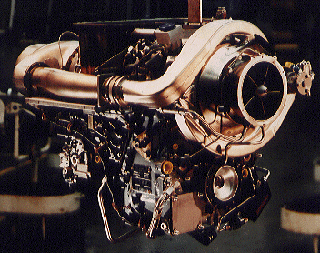




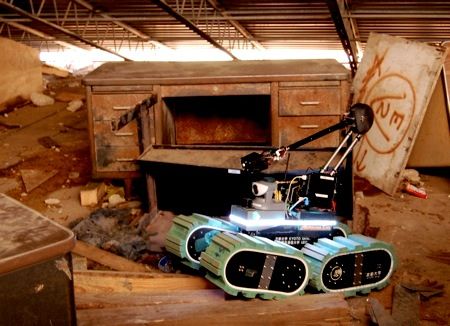
 The teams flew home as soon as they heard about the quake, arriving in Japan the next day. Prof. Tadokoro left Narita airport driving to his home in Sendai carrying on the trunk of his vehicle a tank-like ground robot called Quince and the Active Scope Camera, a remote-controlled snake-like robot.
The teams flew home as soon as they heard about the quake, arriving in Japan the next day. Prof. Tadokoro left Narita airport driving to his home in Sendai carrying on the trunk of his vehicle a tank-like ground robot called Quince and the Active Scope Camera, a remote-controlled snake-like robot.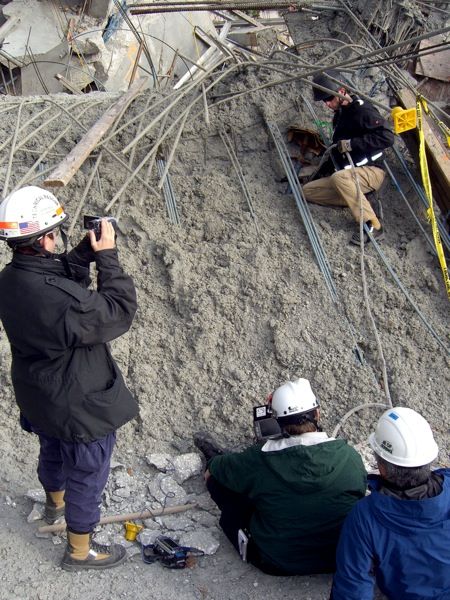
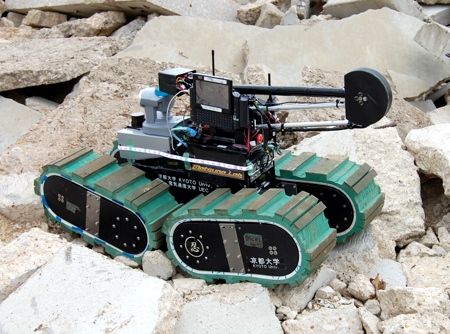

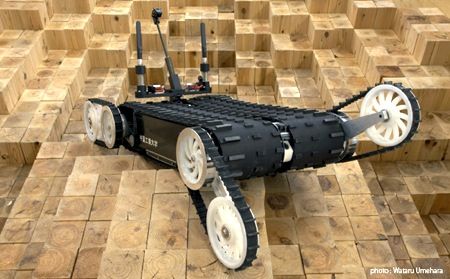
 Like most search and rescue robots, the systems the Japanese are deploying are designed to go where humans can't easily reach. According to a 2007 paper, the Active Scope Camera is a snake-type of robot whose body is covered by "cilia," small filaments that vibrate, allowing the robot to crawl at a speed of 4.7 centimeters per second, climb over obstacles, follow walls, and make turns in tight spaces.
Like most search and rescue robots, the systems the Japanese are deploying are designed to go where humans can't easily reach. According to a 2007 paper, the Active Scope Camera is a snake-type of robot whose body is covered by "cilia," small filaments that vibrate, allowing the robot to crawl at a speed of 4.7 centimeters per second, climb over obstacles, follow walls, and make turns in tight spaces.





 1250 conversion
1250 conversion boring cases for 88'' conversion
boring cases for 88'' conversion checking squish band and valve clearence on 88" conversion
checking squish band and valve clearence on 88" conversion
 Lobe swing clearance.
Lobe swing clearance. XB '04 head modified and ported for 88" conversion. This head has mantained the pear bathtab chamber shape to work with a dished piston and a moderate 10:1 compression ratio not for the most powerfull configuration but for the most streatable power deliver. It will be working with Redshifts 630/585 cams.
XB '04 head modified and ported for 88" conversion. This head has mantained the pear bathtab chamber shape to work with a dished piston and a moderate 10:1 compression ratio not for the most powerfull configuration but for the most streatable power deliver. It will be working with Redshifts 630/585 cams.






 SMALLFRAME ENGINECASES FOR M1 KIT WITH MALOSSI REED BLOCK MODIFIED FOR TASSINARI V FORCE.
SMALLFRAME ENGINECASES FOR M1 KIT WITH MALOSSI REED BLOCK MODIFIED FOR TASSINARI V FORCE.  SMALLFRAME INLET PORT OPENED FOR MALOSSI REED BLOCK
SMALLFRAME INLET PORT OPENED FOR MALOSSI REED BLOCK LARGEFRAME ENGINECASES FOR MALOSSI 210, MMW1 REED BLOCK
LARGEFRAME ENGINECASES FOR MALOSSI 210, MMW1 REED BLOCK







